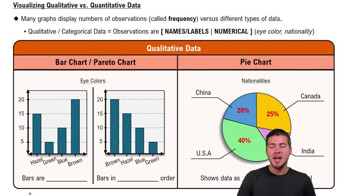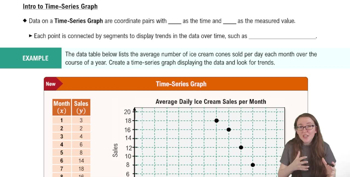Name each level of measurement for which data can be quantitative.
Table of contents
- 1. Intro to Stats and Collecting Data1h 14m
- 2. Describing Data with Tables and Graphs1h 55m
- 3. Describing Data Numerically2h 5m
- 4. Probability2h 16m
- 5. Binomial Distribution & Discrete Random Variables3h 6m
- 6. Normal Distribution and Continuous Random Variables2h 11m
- 7. Sampling Distributions & Confidence Intervals: Mean3h 23m
- Sampling Distribution of the Sample Mean and Central Limit Theorem19m
- Distribution of Sample Mean - Excel23m
- Introduction to Confidence Intervals15m
- Confidence Intervals for Population Mean1h 18m
- Determining the Minimum Sample Size Required12m
- Finding Probabilities and T Critical Values - Excel28m
- Confidence Intervals for Population Means - Excel25m
- 8. Sampling Distributions & Confidence Intervals: Proportion1h 12m
- 9. Hypothesis Testing for One Sample3h 29m
- 10. Hypothesis Testing for Two Samples4h 50m
- Two Proportions1h 13m
- Two Proportions Hypothesis Test - Excel28m
- Two Means - Unknown, Unequal Variance1h 3m
- Two Means - Unknown Variances Hypothesis Test - Excel12m
- Two Means - Unknown, Equal Variance15m
- Two Means - Unknown, Equal Variances Hypothesis Test - Excel9m
- Two Means - Known Variance12m
- Two Means - Sigma Known Hypothesis Test - Excel21m
- Two Means - Matched Pairs (Dependent Samples)42m
- Matched Pairs Hypothesis Test - Excel12m
- 11. Correlation1h 6m
- 12. Regression1h 50m
- 13. Chi-Square Tests & Goodness of Fit1h 57m
- 14. ANOVA1h 57m
1. Intro to Stats and Collecting Data
Intro to Stats
Problem 1.2.14
Textbook Question
Determine whether the data are qualitative or quantitative. Explain your reasoning.
Response times for a customer service representative
 Verified step by step guidance
Verified step by step guidance1
Step 1: Understand the definitions of qualitative and quantitative data. Qualitative data describes categories or qualities and is non-numerical (e.g., colors, names, or labels). Quantitative data represents numerical values that can be measured or counted (e.g., height, weight, or time).
Step 2: Analyze the given data type. The problem mentions 'response times,' which are measured in units such as seconds, minutes, or hours. These are numerical values.
Step 3: Determine if the data can be used for mathematical operations. Since response times can be added, subtracted, averaged, etc., this confirms that the data is quantitative.
Step 4: Consider whether the data represents a measurable quantity. Response times measure the duration of an event, which is a measurable quantity, further supporting that it is quantitative.
Step 5: Conclude that the data is quantitative because it consists of numerical values that represent measurable durations and can be used in mathematical calculations.
 Verified video answer for a similar problem:
Verified video answer for a similar problem:This video solution was recommended by our tutors as helpful for the problem above
Video duration:
1mPlay a video:
Was this helpful?
Key Concepts
Here are the essential concepts you must grasp in order to answer the question correctly.
Qualitative Data
Qualitative data refers to non-numeric information that describes characteristics or qualities. This type of data is often categorical, meaning it can be divided into groups or categories based on attributes. Examples include colors, names, or types of responses, which provide insights into the qualities of the subject being studied.
Recommended video:
Guided course

Visualizing Qualitative vs. Quantitative Data
Quantitative Data
Quantitative data consists of numeric values that can be measured and analyzed statistically. This type of data can be further classified into discrete (countable) and continuous (measurable) data. Examples include age, height, or response times, which allow for mathematical operations and statistical analysis to derive meaningful conclusions.
Recommended video:
Guided course

Visualizing Qualitative vs. Quantitative Data
Response Times
Response times refer to the duration it takes for a customer service representative to reply to a customer inquiry. This measurement is quantitative, as it is expressed in units of time (e.g., seconds or minutes) and can be analyzed to assess performance, efficiency, and customer satisfaction. Understanding response times is crucial for evaluating service quality.
Recommended video:

Creating Time-Series Graphs

 2:13m
2:13mWatch next
Master Introduction to Statistics Channel with a bite sized video explanation from Patrick
Start learningRelated Videos
Related Practice
Textbook Question
1
views
